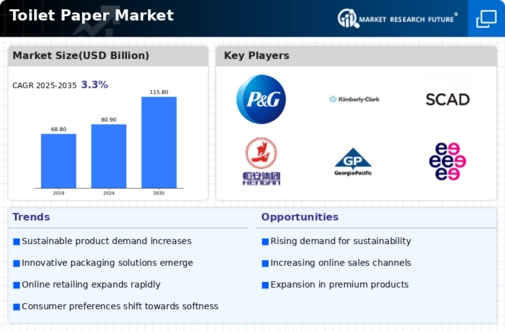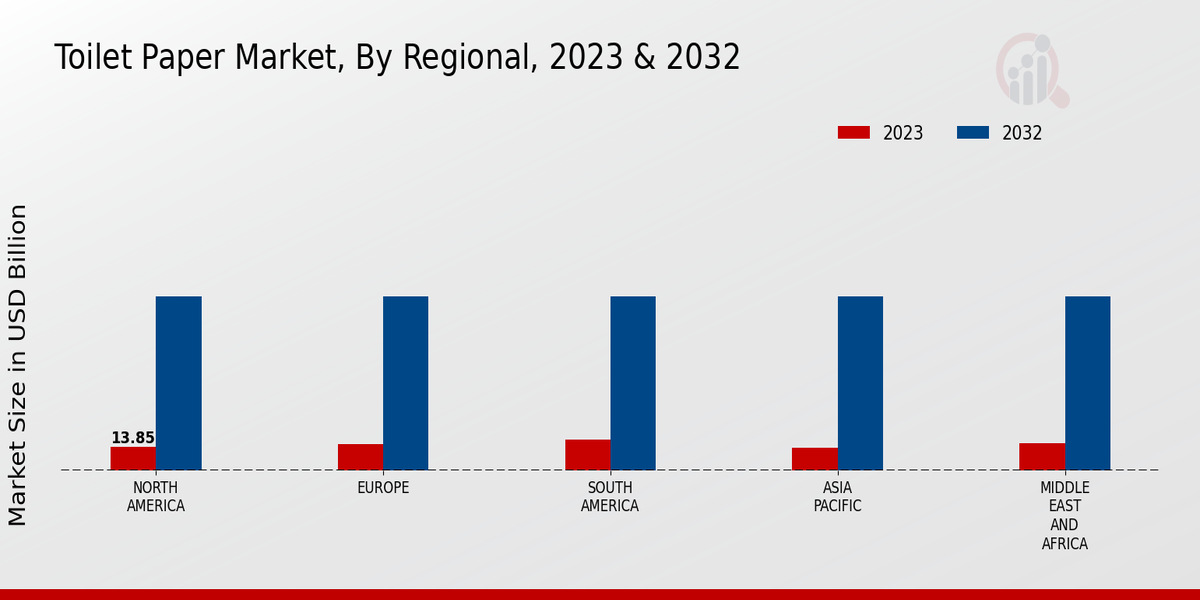Sustainability Trends
Sustainability has emerged as a significant trend influencing the Global Toilet Paper Market Industry. Consumers are increasingly favoring eco-friendly products, prompting manufacturers to adopt sustainable practices. This includes sourcing raw materials from responsibly managed forests and utilizing recycled fibers in production. Companies that prioritize sustainability not only enhance their brand image but also cater to a growing segment of environmentally conscious consumers. As a result, the market is witnessing a shift towards biodegradable and sustainable toilet paper options, which could potentially drive growth. This trend aligns with the projected market value of 115.8 USD Billion by 2035, as consumers increasingly seek products that align with their values.
Rising Global Population
The increasing global population is a pivotal driver for the Global Toilet Paper Market Industry. As the world population is projected to reach approximately 8.5 billion by 2030, the demand for essential hygiene products, including toilet paper, is likely to surge. This demographic shift necessitates higher production and distribution of toilet paper to meet the needs of households and public facilities. The growing awareness of hygiene standards, particularly in developing regions, further amplifies this demand. Consequently, the Global Toilet Paper Market Industry is expected to witness substantial growth, contributing to an estimated market value of 80.9 USD Billion in 2024.
Market Growth Projections
The Global Toilet Paper Market Industry is poised for substantial growth, with projections indicating a market value of 80.9 USD Billion in 2024 and an anticipated increase to 115.8 USD Billion by 2035. This growth trajectory suggests a compound annual growth rate of 3.32% from 2025 to 2035. Factors such as rising population, increased hygiene awareness, and sustainability trends are likely to drive this expansion. The market's evolution reflects changing consumer preferences and the industry's adaptability to meet emerging demands. These projections underscore the potential for investment and innovation within the Global Toilet Paper Market Industry.
Technological Advancements
Technological advancements play a crucial role in shaping the Global Toilet Paper Market Industry. Innovations in manufacturing processes, such as automation and improved production techniques, enhance efficiency and reduce costs. These advancements enable companies to produce high-quality toilet paper at competitive prices, thereby attracting a broader consumer base. Additionally, the integration of digital technologies in supply chain management streamlines operations, ensuring timely delivery and inventory management. As the industry evolves, these technological improvements are likely to contribute to a compound annual growth rate of 3.32% from 2025 to 2035, further solidifying the market's growth trajectory.
Increased Awareness of Hygiene
The heightened awareness of hygiene practices globally is a significant driver of the Global Toilet Paper Market Industry. As consumers become more conscious of health and sanitation, the demand for toilet paper as a basic hygiene product continues to rise. This trend is particularly evident in urban areas, where access to sanitation facilities is crucial. Public health campaigns and educational initiatives further reinforce the importance of hygiene, leading to increased consumption of toilet paper. The market's growth is reflected in the anticipated market value of 80.9 USD Billion in 2024, as consumers prioritize hygiene in their purchasing decisions.
Urbanization and Lifestyle Changes
Urbanization and changing lifestyles are transforming the Global Toilet Paper Market Industry. As more people migrate to urban areas, the demand for convenience products, including toilet paper, is on the rise. Urban dwellers tend to have higher disposable incomes and are more inclined to purchase premium toilet paper products. This shift in consumer behavior is driving manufacturers to innovate and diversify their product offerings to cater to urban consumers' preferences. The market is expected to benefit from this trend, contributing to the overall growth and reaching an estimated value of 115.8 USD Billion by 2035.



















